Anti-tank gun Pak 35 / 36: shadow blitzkrieg symbol
Before the attack on the USSR in the summer of 1941, these small quick-firing anti-tank guns looked pretty confident on the battlefields in Europe, becoming one of the shadow symbols of the German blitzkrieg, the mention of which usually draws tank wedges and dominating the sky aviation enemy, and not at all small 37-mm guns, of which, however, in each Wehrmacht infantry division the state had at least 72 pieces. In total, during the years of World War II, German industry produced more than 16,5 thousand of these tools.
It is worth noting that the Pak 35 / 36 cannon fit in perfectly with the blitzkrieg concept. Possessing a small mass, in the stowed position no more than 440 kg, this weapon could be transported by a variety of vehicles, even fairly light vehicles, for example, Horch Kfz.15 reconnaissance vehicles. The speed of carriage along the highway was up to 50 km / h. On the battlefield, the weapon was also maneuverable, the calculation could quickly change position by rolling the weapon on its own.
History Development of
After the end of the First World War, the General Headquarters of Germany attached exceptional importance to tanks on the battlefield. The German military was actively working on plans for the use of tanks in future armed conflicts in Europe, as well as how to combat the enemy’s armored vehicles. To conduct hostilities without resolving the issue of anti-tank defense was unthinkable for the German general staff. Initially, the fight against tanks was considered a priority for field artillery. At the same time, a limited number of 77-mm cannons and 105-mm howitzers, which Germany was allowed to leave in service, had rather limited capabilities to combat armored vehicles. Light mortars, which were part of the regular armament of infantry regiments, could not help either.
In the middle of the 1920-ies, it became obvious that for an effective anti-tank struggle, you need to create a specialized weapon. This gun was supposed to operate in conjunction with the infantry or in close proximity to its combat formations. In this case, field artillery would be located in the depths of the defense, being attracted to the shelling of armored vehicles only if she had already broken through the defensive orders of the infantry.
The alleged anti-tank gun should ideally meet three basic requirements:
- to ensure the protection of infantry from enemy tanks;
- be able to effectively deal with the enemy infantry;
- to be light and compact.
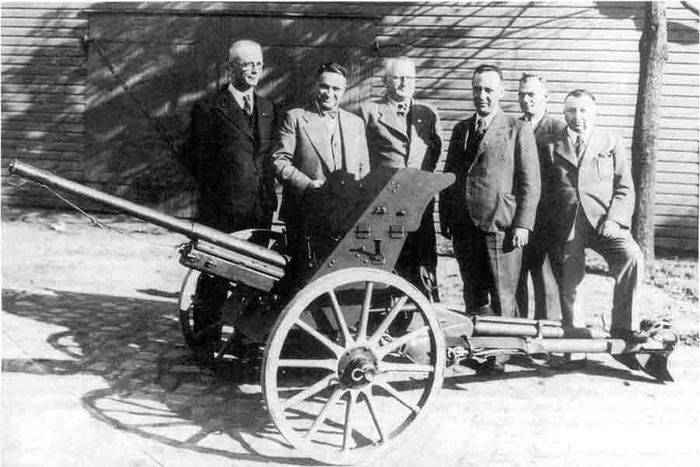
The second requirement - the fight against the enemy's manpower - required a fairly large-caliber guns - from 75-mm and above. Only such high-explosive fragmentation shells would ensure the defeat of infantry in the trenches or located behind various shelters. Serial production of 75-mm anti-tank gun Pak-40 Germany managed to establish only in February 1940 year. Therefore, in the 1920-s, lightness and compactness came to the fore for the creation of anti-tank guns, while the gun should have been able to fire direct-fire with armor-piercing projectiles with the highest possible speed. Other requirements of the German military were the high firing rate of the gun and the large angle of horizontal guidance, armor penetration at the level of 40 mm at a distance of 500 meters and a low line of fire (like the height of the gun), which improved the disguise of the gun on the battlefield. The anti-tank gun was supposed to be pretty light in order to roll freely in combat in the forces of calculation. Outside the battlefield, the transportation of the weapon was to be provided with a harness from one horse.
Designing a new anti-tank guns was carried out in Germany under the conditions of the restrictions of the Versailles Treaty, which forbade the Germans to develop and produce anti-tank artillery. Therefore, the work was carried out in an atmosphere of strict secrecy. Despite the constant underfunding of the Reichswehr during this period of time, work on the creation and purchase of 37-mm anti-tank guns hit the list of priority programs in 1927. This meant that in the event of imminent war, they should have been in the presence of German troops. Already in 1928, the first two prototypes of a new anti-tank gun were assembled in Germany, at the same time 37-mm armor-piercing projectile, a fuse and a brass sleeve were ready.
By May 1929, the first 13 anti-tank guns were launched in Germany, 5 of which was accepted by the customer, and 100 guns were also ordered. Production of 37-mm anti-tank guns engaged concern Rheinmetall-Waffe. 3,7 cm Pak guns have passed a test cycle at the Kummersdorf test site. At the beginning of 1930, the tests of the new artillery system were successfully completed. The program to create a German anti-tank gun came to an end. Thus, Germany became the first country to create an anti-tank weapon of our usual type - a long barrel and a sufficiently powerful armor-piercing ammunition provided a high initial velocity of the projectile, a large shield covered the calculation from bullets and shrapnel, sliding beds ensured a large angle of aiming the gun in the horizontal plane .
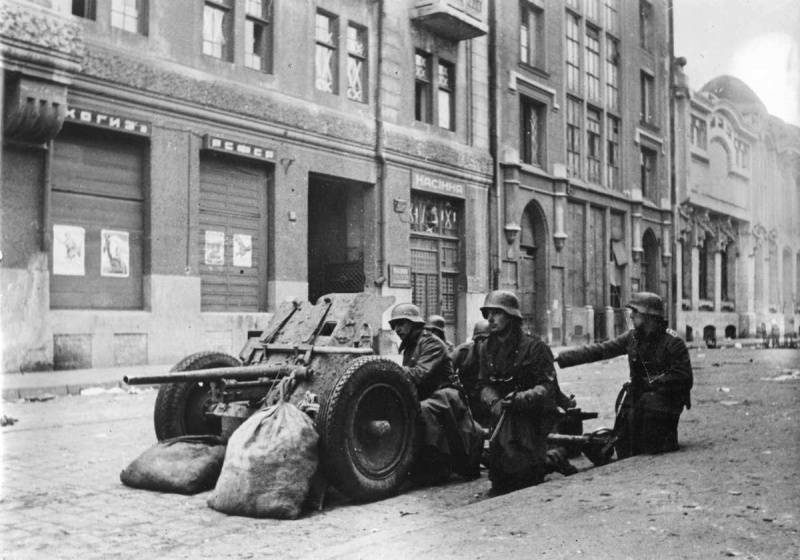
The new weapon in 1928 was adopted under the designation 3,7 cm Pak 28, later a modification of the Pak 29 appeared, which went into mass production. It was this weapon that became the prototype of the famous Pak 35 / 36 anti-tank gun. Their main difference, which immediately catches the eye, were wooden wheels without suspension on 1920's guns. Soviet specialists from the GAU RKKA quickly showed interest in the new German anti-tank gun. They decided to purchase several cannons, drawings and working documentation for them with the aim of setting up production of tools in the Soviet Union. The corresponding agreement was signed in 1930 year. With minor design changes, the German gun was adopted by the Red Army under the designation "37-mm anti-tank gun of the 1930 model of the year" (1-K, GAU index 52-П-162). Ammunition from the German and Soviet guns were completely interchangeable.
Later in the Soviet Union, on the basis of this anti-tank weapon, a constructively similar, but already 45-mm anti-tank gun - the famous “forty-five” was created. History often likes to show us similar conflicts. Ironically, these two weapons: the German 37-mm anti-tank gun and the main 45-mm anti-tank gun of the Red Army of the second half of the 1930-s will have to meet on the battlefield. At the same time, the Soviet Sorokapyatka conquered the entire Great Patriotic War.
In the 1934 year, due to the conversion of the 3,7 cm Pak implement to mechanical traction, it was upgraded. Most of the modernization related to wheel travel. Launch guns suspended and equipped with new pneumatic wheels instead of wooden ones. This was necessary in order to provide the gun with a greater speed of transportation with the help of various automobiles and tractors. The new version of anti-tank guns received the designation Pak 35 / 36.
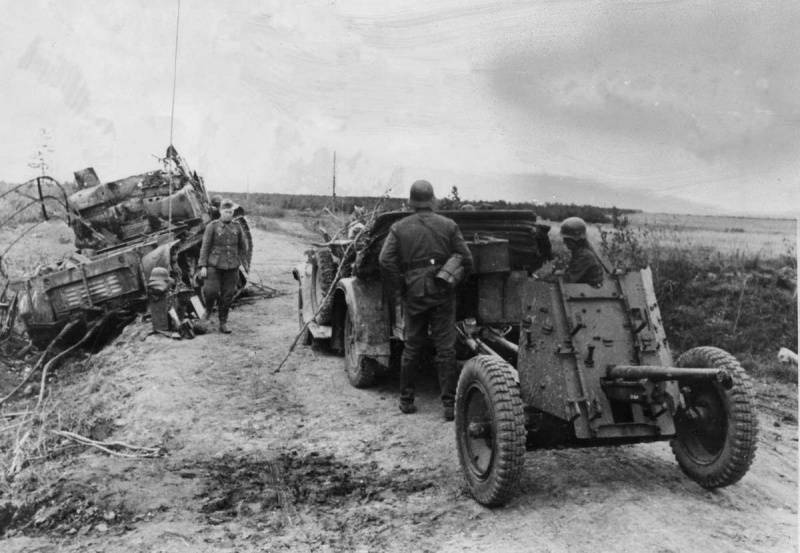
The Pak 35 / 36 anti-tank gun had a rather modern design for its time. The gun had a light two-wheeled carriage with sliding beds, sprung wheel travel, metal wheels with rubber tires. The recoil brake was hydraulic, spring-loaded, a wedge horizontal shutter with an automatic closing mechanism was used, which made it possible to increase the rate of fire. On 1 September 1939, the Wehrmacht had 11 200 anti-tank guns 35 / 36.
Combat use and features
The Pak 35 / 36 anti-tank guns were in service with Wehrmacht infantry divisions, which were saturated with these guns. Statewide on 1 in May 1939, the infantry division was supposed to have 75 such guns. One motorized anti-tank company (12 cannons) in each of the three infantry regiments, in the anti-tank battalion (3 companies with 12 guns), three more guns were at the disposal of a squadron of heavy guns of the reconnaissance battalion. The ammunition of each anti-tank gun included 220 shells.
These guns largely contributed to the success of the blitzkrieg. Possessing high mobility, they always appeared where it was needed. The German infantry always had a tool at hand that helped repel the attacks of the enemy’s armored vehicles. Light tanks of that time period could quickly turn these German guns (10-15 rate of fire per minute) into a sieve. It was precisely the high saturation of the Wehrmacht infantry units with these weapons that seriously hampered the counterattacks of Soviet tank and mechanized units in the first weeks of World War II. The 37-mm shells of the German guns easily hit the T-26 tanks, all types of BT tanks and BA armored cars, which made up the bulk of Soviet armored vehicles.
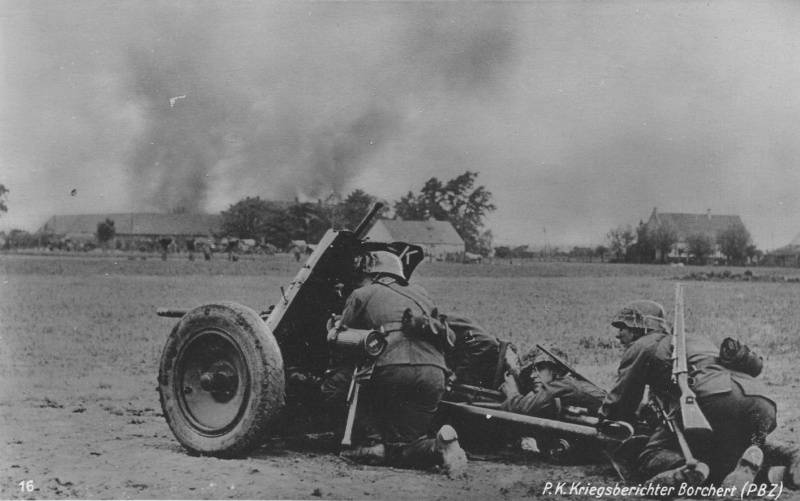
True, then the German gunners had to face the formidable T-34 and KV tanks. At the same time, under certain conditions, the Pak 35 / 36 gun could hit the medium tank T-34. It was quite easy for the gun to penetrate the lower part of the side of this Soviet tank, where the thickness of the armor without rational tilt angles did not exceed 40 mm. Possible was the defeat of tanks in the side and stern of the cast turret. When it hit the base of the turret of the T-34 tank, the projectile could cause it to jam. In addition, the elements of the frontal part of the tank were even classified as vulnerable parts of the tank - a mechanical drive hatch and a machine gun installation.
Moreover, at the disposal of the German gunners already then in sufficient quantities there were sub-caliber shells. The 3,7 cm Pzgr.40 “coil” type piercing armor-piercing projectile pierced 300 mm of armor at a distance of 50 meters at a meeting angle of 90 degrees, and on 100 meters armor penetration grew to 75 mm. At the angle of meeting with the armor 60 degrees, the figures were 40 and 50 mm, respectively. So even 37-mm German guns could fight T-34 tanks under certain conditions, but the striking effect of their shells on T-34 tanks was clearly insufficient. After penetrating the armor, the tanks did not always fail, as there was not a sufficient number of dangerous fragments, due to the small size and power of 37-mm ammunition. At the same time, the KV 37-mm tank was not hit at all by the German anti-tank gun.
Meeting with new Soviet tanks became an unpleasant surprise for Pak 35 / 36, as the number of T-34 and KV tanks on the battlefield increased, the effectiveness of these guns fell. However, contrary to the opinion of many people, the gun went off the stage rather slowly. The production of guns was stopped at the very beginning of the 1942 of the year, by which time the German industry had produced more than 16,5 thousands of guns of this type. In this case, the gun was actively used at the front and after the completion of production. In 1942, the Pak 35 / 36 gun was still the main Wehrmacht anti-tank weapon. In 1943, the Germans spent about two million 37-mm shells of all types (for comparison, 75-mm shells for the same period - 1,25 million), that is, in 1943, the Germans still widely used gun Pak 35 / 36. But already in the 1942-1943 years, the gun was actively replaced by more advanced guns of large calibers.
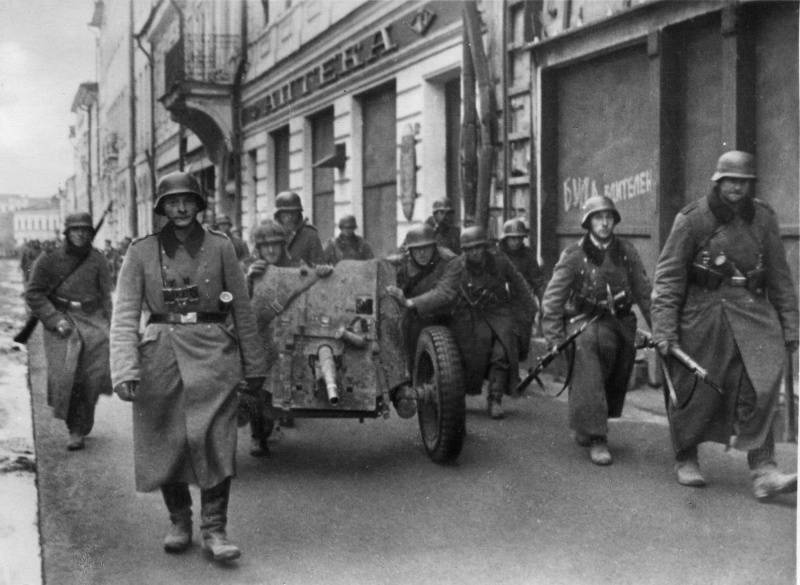
For its time, the Pak 35 / 36 gun was certainly very successful. This assessment is confirmed by the wide spread of this anti-tank gun (as well as guns created on its base) around the world. The Pak 35 / 36 anti-tank gun advantageously combined a high initial projectile speed (762 m / s armor-piercing, 1030 m / s podkaliberny), light weight and size, the ability to quickly transport with almost any transport, greater rate of fire. The gun easily rolled over the battlefield from one position to another by the forces of 5 people, easily camouflaged on the ground due to the small height. At the same time, the weaknesses of the gun were attributed not sufficiently strong armor action of small-sized projectiles. Very often, in order to disable an enemy tank, the calculation required a series of hits with armor penetration. In this case, the rate of fire and good ballistics came to the rescue, which allowed the enemy tanks to literally fall asleep with shells.
For most 1930 tanks, this German gun was deadly. However, along with the widespread use of tanks with anti-missile armor, the fate of the gun was decided. And yet, the presence in her ammunition subcaliber, and then cumulative shells somewhat extended the life of her front-line life. And in 1943, the gun, already gone from the first roles, could surely hit various types of light tanks, armored personnel carriers and self-propelled guns of the countries participating in the anti-Hitler coalition.
Pak 35 / 36 performance characteristics:
Caliber - 37 mm.
Barrel length - 1665 mm (45 gauges).
Overall dimensions (in the stowed position): length - 3450 mm, width - 1650 mm, height - 1170 mm, clearance - 270 mm.
Weight - 440 kg (in the stowed position), 480 kg (in the fighting position).
The angle of horizontal guidance - 60 degrees.
The angle of the vertical pickup is from -8 to + 25 degrees.
The rate of fire - 10-15 shots per minute.
Wagon speed on the highway - up to 50 km / h.
Calculation - 5 people.
Information sources:
http://ww2tanki.ru/artilleriya-vtoroj-mirovoj-vojny/artillery-germaniya/pta-germanija/3-7-cm-pak
http://www.militaryfactory.com/armor/detail.asp?armor_id=286
http://don1942.ru/vooruzhenie/item/nem-37mm
Open source materials
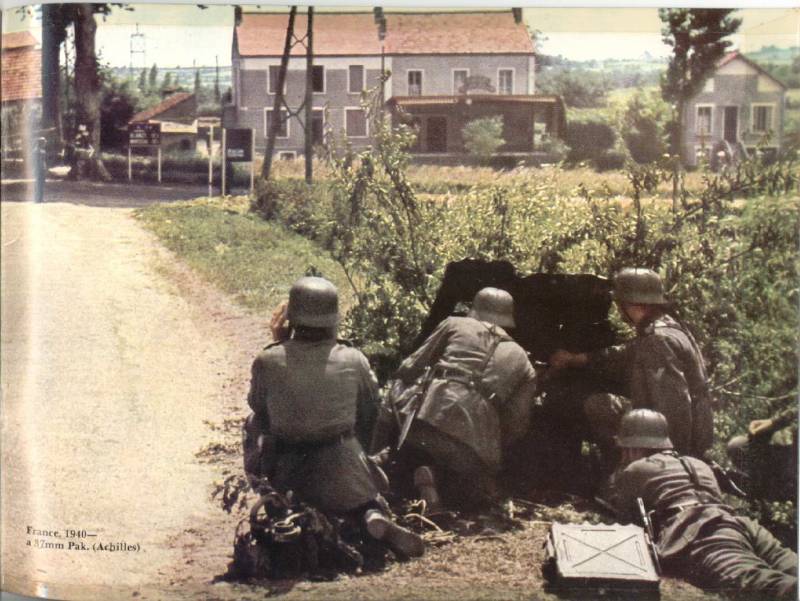
Information